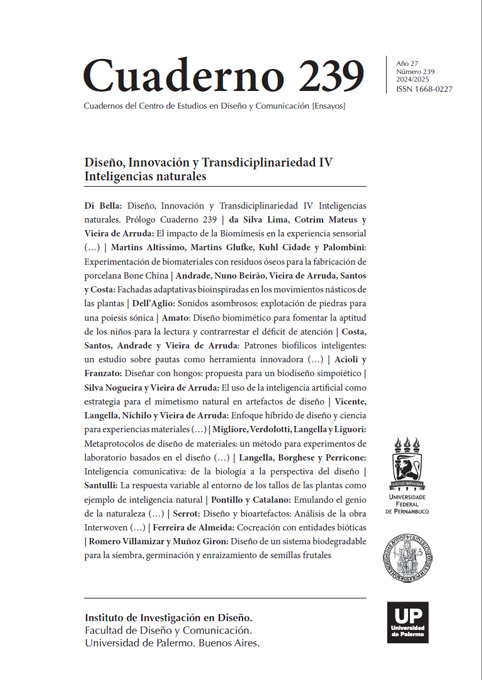The impact of Biomimicry on sensory experience: an analysis of the relationship between human senses and nature in the design process in Architecture
Resumen
Este artículo explora el campo de la biomímesis en la arquitectura, centrándose en la integración de soluciones inspiradas en la naturaleza para enriquecer la experiencia sensorial de los usuarios en los espacios construidos.
Citas
Archdaily. (2015). Bosco Verticale / Boeri Studio. https://www.archdaily.com/777498/boscoverticale-stefano-boeri-architetti
Archello. (n.d.). Shanghai Expo 2010 British Pavilion. https://archello.com/project/shanghaiexpo-2010-british-pavilion
Architect. (2020). Sound of Wind. https://www.architectmagazine.com/project-gallery/sound-of-wind
Badarnah, L. (2012). Towards the living envelope: Biomimicry for buildings envelope adaptation. [PhD Thesis, Technische Universiteit Delft]. Institutional Repository of TU
DELFT https://repository.tudelft.nl/islandora/object/uuid%3A4128b611-9b48-4c8db52f-38a59ad5de65
Benyus, J. M. (2006). Biomimicry: Innovation inspired by nature (p. 320). New York: Morrow.
Chung, T. Y. (2015). A Study on the Background and Characteristics of Pallasmaa’s Architectural Phenomenology. Korean Institute of Interior Design Journal, 24(2), 42-49.
Cipolla, G. M. P. (2020). The Living Chapel. L’installazione di design ecologico all’Orto
Botanico di Roma. Artribune. https://www.artribune.com/arti-visive/2020/06/the-livingchapel-installazione-ecologia-orto-botanico-di-roma/
Clementino, T., Soares, T., & Arruda, A. (2021). Communication by analogy: the contribution of memory as a facilitator of the perception of biomimetic artifacts. Cuadernos del
Centro de Estudios en Diseño y Comunicación. Ensayos, (149), 167-187.
Elsakksa, A., Marouf, O., & Madkour, M. (2022). Biomimetic Approach for Thermal Performance Optimization in Sustainable Architecture. Case study: Office Buildings in Hot
Climate Countries. In IOP Conference Series: Earth and Environmental Science (Vol. 1113,
No. 1, p. 012004). IOP Publishing.
Farr, M., & Macruz, A. (2020). Multi-sensory Materiality-Expanding Human Experience
and Material Potentials with Advanced HoloLens Technologies and Emotion Sensing
Wearables. Proceedings of the 25th International Conference of the Association for
Computer-Aided Architectural Design Research in Asia (CAADRIA) 2020, v.1, 721-730.
Hong Kong.
Granata, G. (2019). Architecture and multisensory. A project of inclusion for the sensory
impaired and a new approach of synaesthetic visit in existing architectural sites. SCIRESIT-SCIentific RESearch and Information Technology, 8(2), 77-84.
Halim, S., & Ekomadyo, A. S. (2022). Experiencing and Feeling Light Through Peter
Zumthor’s Architectural Works. Jurnal Arsitektur, 12(2), 145-164.
Jamei, E., & Vrcelj, Z. (2021). Biomimicry and the built environment, learning from nature’s
solutions. Applied sciences, 11(16), 7514.
Jia, J. J., & Liu, S. F. (2013). Exquisite Representation in Peter Zumthor’s Works. Applied
Mechanics and Materials, 423, 1178-1182.
Koerner, B. (2022). Sublimion. Lucept Koerner Design. https://lucept.com/2022/03/03/sublimotion/
Kraus, S. (2017). Peter Zumthor Kolumba Museum. Divisare. https://divisare.com/projects/349228-peter-zumthor-rasmus-hjortshoj-kolumba-museum
Lehman, M. L. (n.d.). Use Nature to Strengthen Your Design Solution. MLL Atelier. https://mllatelier.com/db/b/use-nature-strengthen-design-solution
McQuarrie, L. (2014). Dining at the High-Tech Sublimion Restaurant Costs a Hefty $2,000.
Trendhunter. https://www.trendhunter.com/trends/sublimotion
OLIVO, Carla Martins; MENEGUETTI, Karin Schwabe. Estética e ecologia: uma dualidade?
Uma busca sistemática para a arquitetura da paisagem| Aesthetics and ecology: a duality? A systematic search for landscape architecture. Oculum Ensaios, v. 18, p. 1-17, 2021.
Pasini, R. (2022). A Dialectics of Ecology and Design in the Reform of Contemporary
Landscapes. Sustainability, 14(10), 6217.
RAA. (n.d.). Sound of Wind. https://www.r-a-architects.com/prj/2013/soundofwind.html
Sciortino, F. (2020). The Living Chapel, Musica e Natura. Metropolitan Magazine. https://metropolitanmagazine.it/living-chapel/
Spence, C. (2020). Senses of place: architectural design for the multisensory mind. Cognitive
Research: Principles and Implications, 5(1), 46.
Stevens, L., Bidwell, D., Fehler, M., & Singhal, A. (2022). The Art and Science of Biomimicry—Abstracting Design Principles from Nature. In Transdisciplinarity (pp. 649-687).
Cham: Springer International Publishing.
Szabo, M., Dumitras, A., Mircea, D. M., Sestras, A. F., & Bruszek, R. F. (2022). Analysis of
compositional lines in natural landscapes. Nova Geodesia, 2(2), 29-29.
Tavsan, C., Tavsan, F., & Sonmez, E. (2015). Biomimicry in architectural design education.
Procedia-social and behavioral sciences, 182, 489-496.
Tunçbilek, G. (2020). Experimentation in architecture: Pavilion design. Athens Journal of
Architecture, 6(4), 397-414.
Tunçbilek, G. Z. (2013). Temporary architecture: the serpentine gallery pavilions [Master’s
thesis, Middle East Technical University]. ODTÜ METU https://open.metu.edu.tr/handle/11511/22980
Van Leeuwen, T. M., Singer, W., & Nikolić, D. (2015). The merit of synesthesia for consciousness research. Frontiers in psychology, 6, 162217.
Wilson, E. O. (1984). Biophilia. Harvard University Press. Cambridge, MA, USA.
Wilson, E. O. (2002). The future of life. Vintage.
WORKac. (2014). Edible Schoolyard. https://work.ac/work/edible-schoolyard-nyc-at-ps-216/
Zumthor, Peter. (2005). Atmospheres: Architectural Environments - Surrounding Objects.
Birkhäuser; Taschen.
Los autores/as que publiquen en esta revista ceden los derechos de autor y de publicación a "Cuadernos del Centro de Estudios de Diseño y Comunicación", Aceptando el registro de su trabajo bajo una licencia de atribución de Creative Commons, que permite a terceros utilizar lo publicado siempre que de el crédito pertinente a los autores y a esta revista.


